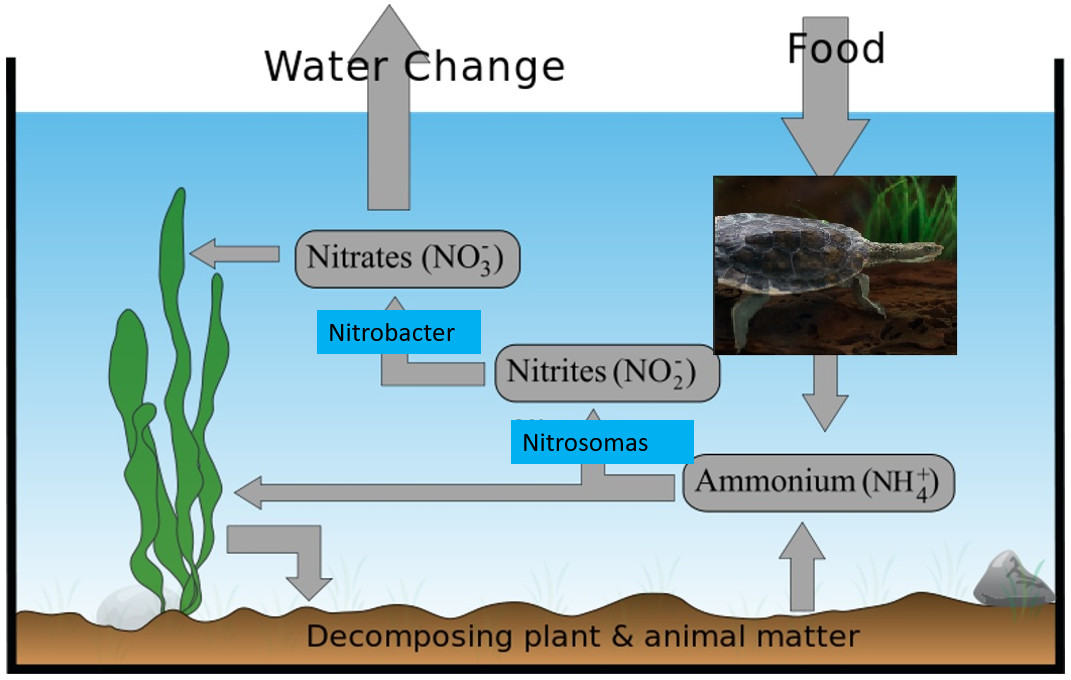Water quality
Turtles live in an aquatic environment. This simple statement reflects the importance of water quality to the health of turtles. They move through the water, they consume their food in the water, and they eliminate waste into the water. Nearly every disease problem in captive turtles is related, in one way or another, to water quality. Turtle owners must, therefore, understand what affects water quality so that you can prevent problems in your turtles, rather than treat them.
What determines water quality?
Water quality is determined by:
- The source of the water
- The establishment of a healthy nitrogen cycle in the tank
- The frequency and volume of water changes
- How the water is filtered
- The water temperature
- The aeration of the water
- Stocking density
The source of the water: Town water is often high in chemicals e.g., chlorine, copper (from copper water pipes), and fluoride; many of these chemicals can be toxic to turtles, even in low concentrations. Always test the water before adding to tank (see below, under monitoring water quality). When adding water, town water should be left to stand for 12 hours before adding it to the tank to release these chemicals as gas. (The use of an airstone to agitate the water can speed up this process). There are also commercial preparations that can be used to neutralise these chemicals.
The nitrogen cycle: Decaying food and turtle waste release ammonia into the water. Ammonia is a highly toxic substance and must be removed from the water. This is done by the nitrogen cycle:
- Step 1: Ammonia is excreted in your turtle’s urine and faeces, and also comes out of decomposing, uneaten food. It is very toxic.
- Step 2: A bacteria, Nitrosomas, converts ammonia into nitrites (still very toxic)
- Step 3: Another bacteria, Nitrobacter, converts nitrites into nitrates (still toxic, but much less so)
- Step 4: Nitrates are taken up by aquatic plants as fertiliser or removed by water changes.
- Step 5: These plants are eaten by the turtle, and the cycle begins again.
It can be seen that, for the nitrogen cycle to work, there must be healthy populations of Nitrosomas and Nitrobacter bacteria in the water – and this is the lynchpin of water quality management.

The frequency and volume of water changes: Because, even in a well-managed tank with a well-established nitrogen cycle, nitrates can build up to toxic levels, it is important to remove some of these nitrates. This is most simply done by regular water changes. Completely changing the water is rarely recommended, as it will disrupt the population of the Nitrosomas and Nitrobacter bacteria and adversely affecting the tank’s nitrogen cycle. Replacing 4-10% of the aquarium water with aged/treated fresh water each week is generally recommended as a means of reducing nitrate concentrations without affecting the nitrogen cycle.
How the water is filtered: Although the nitrogen cycle can remove much of the ammonia and nitrites in the water, solid waste and other chemicals need to be removed by filtration. Aquarium filters can be either internally or externally mounted; as a general rule, external filters have a much higher filtering capacity. Filters can be mechanical (sponge/gauze to remove solid waste); chemical (activated charcoal to remove chemicals); biological (plastic biospheres that are coated with Nitrosomas and Nitrobacter bacteria); or a combination of all of the above. N.B. It is very important to remember that, when cleaning a filter, only tank water is used. Otherwise, the beneficial bacteria on the biospheres and in the filter can be destroyed and lead to ‘ammonia shock’ in the tank.
The water temperature: It must be remembered that tropical streams (turtles’ natural habitat) have a fairly constant temperature (15° – 20°C), and that variation, even in shallow water, is usually less than 3°C. Turtle tanks may need to be heated to maintain a temperature of 23°C – 26°C (the preferred thermal gradient for turtles). Aquarium heaters are usually thermostatically controlled; as a general rule, 2-4 watts is required to heat 4 litres of water.
Aeration: Even though turtles live in water, they need oxygen to live. Although turtles breathe through their nostrils when their head is out of the water, the aquarium plants and any other inhabitants need aerated water. Oxygen enters the water from the air above it. The amount absorbed is increased by rippling the water surface; this is done by air stones and spray bars. Dissolved oxygen is reduced by the presence of decaying food; too many plants; or high temperatures.
Stocking density: As with any captive husbandry situation, aquariums are overcrowded when compared to nature. Even one turtle in one tank is a higher rate than occurs naturally. A turtle, a few feeder fish, and a couple of freshwater crayfish (yabbies) will cause an increased oxygen consumption, increased waste, and a higher likelihood of disease spreading. Stocking density is therefore an important husbandry principle.
Monitoring water quality
It should be obvious by now that water quality is important, and it needs to be monitored regularly. This is done through the use of commercial aquarium kits; the suggested minimal parameters are temperature; pH; ammonia; nitrites; nitrates; and hardness. Water quality should be checked every 1-2 weeks, and after every water change.
References
Jessop M, Bennett T (2010) Tortoises and Turtles. In: Meredith A, Johnson‐Delaney C (eds) BSAVA Manual of Exotic Pets: A Foundation Manual, 5th ed. British Small Animal Veterinary Association, Gloucester, pp 249–272
Johnson J (2004) Husbandry and medicine of aquatic reptiles. Seminars in Avian and Exotic Pet Medicine 13:223–228
Kischinovsky M, Raftery A, Sawmy S (2017) Husbandry and Nutrition. Reptile Medicine and Surgery in Clinical Practice
